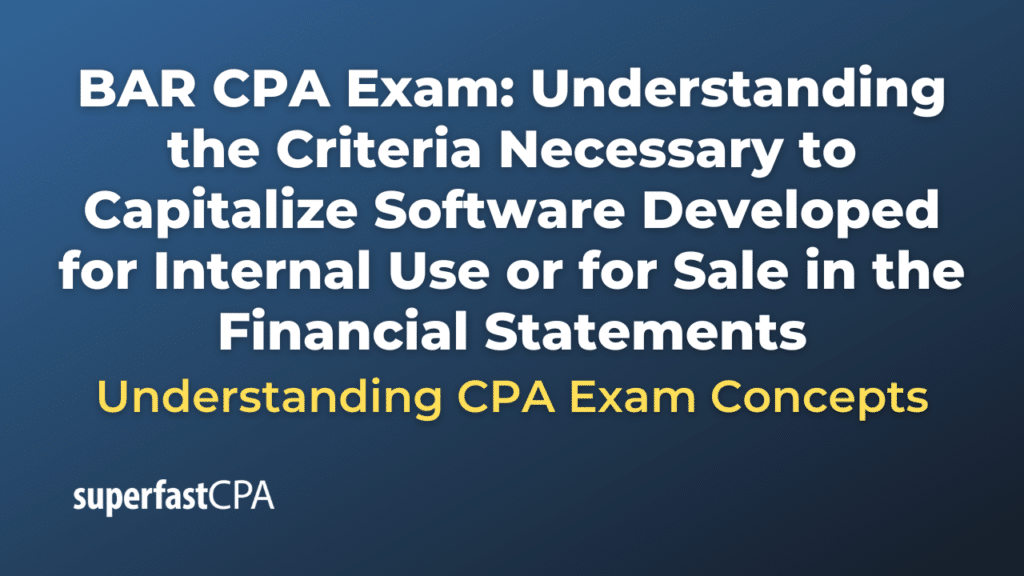Introduction
Overview of the Importance of Software Capitalization
In this article, we’ll cover understanding the criteria necessary to capitalize software developed for internal use or for sale in the financial statements. In today’s increasingly digital world, software development is a significant investment for many businesses. Whether developed for internal use or for sale to customers, software represents a valuable asset that can drive operational efficiency, innovation, and revenue generation. Properly capitalizing these software costs on the financial statements ensures that the value of this asset is accurately reflected and aligned with the economic benefits it provides over time.
Software capitalization allows businesses to allocate the costs associated with software development over the period in which the software will generate revenue or be used productively. This process not only enhances the accuracy of financial reporting but also aligns with the matching principle, which requires that expenses be recognized in the same period as the revenues they help generate.
The Importance of Understanding Capitalization Criteria
Understanding the criteria necessary for capitalizing software is crucial for accurate financial reporting. The process of determining which costs should be capitalized and which should be expensed can be complex, particularly as software development typically occurs in multiple stages, each with different accounting implications. Missteps in this area can lead to either understating or overstating assets and expenses, which in turn can distort a company’s financial health and performance.
Accurately capitalizing software costs is not just about compliance; it is also about providing stakeholders, such as investors and creditors, with a clear and truthful picture of the company’s financial position. This transparency is vital for maintaining trust and ensuring that financial statements are a reliable basis for decision-making.
Relevant Accounting Standards
To properly capitalize software costs, it is essential to follow the relevant accounting standards that provide detailed guidance on how and when to capitalize these costs. In the United States, the primary standards governing software capitalization are:
- ASC 350-40 (Internal-Use Software): This standard provides the guidelines for capitalizing software developed or obtained for a company’s internal use. It outlines the various stages of software development and specifies the types of costs that can be capitalized during each stage.
- ASC 985-20 (Software to Be Sold, Leased, or Marketed): This standard applies to software that is developed with the intent to be sold, leased, or otherwise marketed. It details the conditions under which software development costs should be capitalized, particularly focusing on the achievement of technological feasibility as a critical criterion.
These standards ensure that software costs are treated consistently and transparently across organizations, allowing for comparable financial reporting. A thorough understanding of these standards is essential for CPA professionals, particularly those preparing for the BAR CPA exam, as it enables them to apply the appropriate criteria and methods in practice.
Understanding Software Capitalization
Definition of Software Capitalization
Software capitalization refers to the accounting practice of recognizing the costs associated with software development as an asset on the balance sheet, rather than expensing them immediately. This approach is based on the premise that the software, once completed, will provide economic benefits to the business over multiple periods. By capitalizing these costs, the expense is allocated over the useful life of the software, typically through amortization, aligning the costs with the periods in which the software generates revenue or is used productively.
Capitalization ensures that the financial statements more accurately reflect the value of long-term assets and the related expenses, providing a clearer picture of a company’s financial health and performance.
Distinction Between Software Developed for Internal Use versus Software Developed for Sale
When it comes to software development, the purpose of the software—whether it is for internal use or for sale—dictates how its costs are treated under accounting standards.
- Software Developed for Internal Use: This type of software is intended to meet the internal operational needs of a business. Examples include enterprise resource planning (ERP) systems, customer relationship management (CRM) software, and other tools designed to improve internal processes. The costs associated with developing or acquiring this software are capitalized during certain stages of the development process, provided that specific criteria are met. The key standard governing this type of software is ASC 350-40.
- Software Developed for Sale: This category includes software that is developed with the intention of selling, leasing, or otherwise marketing it to external customers. Examples include commercial software applications, video games, and software as a service (SaaS) platforms. The costs associated with developing this software are capitalized only after technological feasibility has been established, as outlined in ASC 985-20. This standard provides guidance on when to begin and cease capitalization, as well as how to amortize the capitalized costs.
Overview of the Stages of Software Development
The software development process typically occurs in three main stages, each with different implications for capitalization:
- Preliminary Project Stage:
- This initial phase involves activities such as conceptual formulation, evaluation of alternatives, and the determination of technology requirements. During this stage, the business explores the feasibility of various software solutions. Costs incurred during this stage, such as planning, are generally expensed as they are not yet directly related to the creation of a software product that will provide future economic benefits.
- Application Development Stage:
- In this stage, the actual software development begins. Activities include coding, testing, and configuring the software to meet the company’s needs (for internal use software) or to be market-ready (for software intended for sale). This is the critical phase for capitalization. For internal-use software, costs incurred during the development phase that meet the criteria set forth in ASC 350-40 are capitalized. For software intended for sale, costs are capitalized only after technological feasibility is established, as per ASC 985-20.
- Post-Implementation/Operation Stage:
- Once the software is ready for its intended use or sale, it enters the post-implementation stage. Activities in this stage may include training, maintenance, and user support. Costs incurred during this phase are typically expensed as they are considered ongoing operating costs rather than development costs. However, any further development that results in additional functionality or enhancement may be capitalized if it meets the criteria of the relevant accounting standards.
Understanding these stages and the associated accounting treatment is essential for accurately determining when to capitalize software costs and ensuring that financial statements reflect the true value of the company’s software assets.
Criteria for Capitalizing Software Developed for Internal Use
Preliminary Project Stage
Activities Involved
The Preliminary Project Stage is the initial phase of software development, where the focus is on conceptualizing the project and determining its feasibility. Key activities in this stage include:
- Conceptual Formulation: Brainstorming and outlining the software’s potential functions and goals.
- Evaluation of Alternatives: Assessing various technical and functional alternatives to achieve the desired objectives.
- Feasibility Analysis: Determining whether the project is technically feasible and aligns with the organization’s strategic goals.
- Vendor Selection (if applicable): Identifying and evaluating potential vendors or software packages that could meet the organization’s needs.
Costs That Should Be Expensed
During the Preliminary Project Stage, all costs incurred should be expensed as they are considered exploratory and do not directly contribute to the creation of an asset that will provide future economic benefits. These costs typically include:
- Research Costs: Costs associated with gathering information and evaluating the feasibility of the project.
- Initial Planning Costs: Expenses related to initial meetings, consultations, and the development of preliminary plans.
- Feasibility Studies: Costs incurred in analyzing the technical and financial feasibility of the software project.
- Vendor Evaluation Costs: If external vendors or off-the-shelf software packages are being considered, costs associated with evaluating these options are expensed.
The rationale for expensing these costs is that, at this stage, the project is still in its infancy, and there is no certainty that the software will be developed or that it will generate future economic benefits.
Application Development Stage
Criteria for Capitalization During This Stage
The Application Development Stage marks the beginning of actual software creation. This is the critical phase where costs can be capitalized, provided that certain criteria are met. The criteria for capitalization during this stage include:
- Management Authorization: The project must have received formal authorization from management to proceed beyond the preliminary stage.
- Completion of the Preliminary Stage: The organization has completed the planning and feasibility assessments, and the project is ready to move forward into development.
- Technological Feasibility: For software to be capitalized, technological feasibility must be established. This means that the organization has identified how the software will be developed and that it is likely the project will be completed and will function as intended.
Types of Costs That Can Be Capitalized
Once the project has met the criteria for capitalization, the following types of costs incurred during the Application Development Stage can be capitalized:
- Coding Costs: Direct costs of writing the software code, including salaries of programmers and other technical staff involved in the development process.
- Testing Costs: Expenses related to testing the software to ensure it meets the necessary requirements and functions correctly.
- Direct Costs of Materials and Services: Costs of materials and services consumed in the development process, such as software licenses for development tools, server time, and other necessary resources.
- External Consultants: Fees paid to external consultants or specialists who contribute to the software’s development.
- Capitalized Interest: If the project is significant and financed through debt, the interest on that debt can be capitalized during the development stage.
Importance of Meeting Technological Feasibility Criteria
Technological feasibility is a pivotal concept in determining when to begin capitalizing software costs. For internal-use software, technological feasibility is established when the organization has completed either the detailed program design or a working model that demonstrates the software can be developed to meet its intended purpose.
Meeting this criterion ensures that only the costs associated with the actual development of the software are capitalized, while costs incurred during the earlier, more speculative phases are appropriately expensed. This approach aligns with the matching principle in accounting, ensuring that expenses are recognized in the same periods as the revenues they help to generate or the operational benefits they provide.
By adhering to these criteria, organizations can ensure that their financial statements accurately reflect the investment in internal-use software, providing stakeholders with a true picture of the company’s financial position.
Post-Implementation/Operation Stage
Activities in This Stage
The Post-Implementation/Operation Stage occurs after the software has been developed and is ready for its intended use. At this point, the software is operational, and the focus shifts to supporting its use within the organization. Key activities during this stage include:
- Training: Providing end-users with the necessary training to effectively use the software.
- Maintenance: Ongoing activities to fix bugs, ensure the software remains functional, and make necessary updates to keep the software compatible with evolving technology.
- User Support: Offering helpdesk services or other forms of support to assist users with any issues that arise during the operation of the software.
- Routine Upgrades: Implementing routine updates or patches to maintain the software’s security and functionality.
Costs That Should Be Expensed During This Stage
All costs incurred during the Post-Implementation/Operation Stage should be expensed as they do not contribute to the creation of a new asset but are rather ongoing operational costs. These include:
- Training Costs: Expenses related to training materials, trainers, and the time spent by employees learning the new software.
- Maintenance Costs: Costs associated with routine maintenance activities, such as bug fixes and minor updates, which ensure the software continues to function as intended.
- Support Costs: Expenses for providing ongoing user support, including salaries for support staff and any external support services.
- Routine Upgrade Costs: Costs incurred for minor upgrades or patches that do not add significant new functionality to the software but are necessary for its continued operation.
Expensing these costs aligns with the accounting principle that costs which maintain or preserve the value of an existing asset should be recognized as incurred, rather than being capitalized.
Impairment Considerations
Overview of Impairment Indicators for Capitalized Software
Once software costs have been capitalized, it is essential to periodically assess whether the software continues to hold its value on the balance sheet. Impairment occurs when the carrying amount of the capitalized software exceeds its recoverable amount, indicating that the asset is no longer expected to generate the anticipated economic benefits.
Common indicators of impairment for capitalized software include:
- Obsolescence: The software has become outdated due to technological advancements or changes in business needs, rendering it less useful or entirely redundant.
- Performance Issues: The software consistently fails to meet performance expectations, leading to reduced utility or operational efficiency.
- Discontinuation of Use: The software is no longer in use, either because it has been replaced by a more effective solution or because the business operations it supported have changed.
- Significant Changes in the Market: Shifts in market demand or the competitive landscape that diminish the software’s expected future cash flows or usefulness to the organization.
How to Test for Impairment and Necessary Adjustments
To test for impairment, organizations should compare the carrying amount of the software to its recoverable amount, which is the higher of:
- Fair Value Less Costs to Sell: The amount obtainable from the sale of the software in an arm’s length transaction, minus the costs of disposal.
- Value in Use: The present value of the future cash flows expected to be derived from the software.
If the carrying amount exceeds the recoverable amount, the software is considered impaired, and an impairment loss must be recognized. The impairment loss is measured as the difference between the carrying amount and the recoverable amount and should be reported in the income statement.
Once an impairment loss is recognized, the carrying amount of the software is adjusted downward. This new carrying amount becomes the software’s new cost basis, and no previously recognized impairment losses can be reversed in future periods.
Regularly testing for impairment ensures that the capitalized software is accurately reflected in the financial statements, providing stakeholders with a realistic view of the company’s assets and their ability to generate future economic benefits. This process is crucial for maintaining the integrity of the financial reporting process and ensuring compliance with relevant accounting standards.
Criteria for Capitalizing Software Developed for Sale
Technological Feasibility
Definition and Criteria to Meet Technological Feasibility
Technological feasibility is a critical milestone in the software development process, particularly for software intended for sale, lease, or marketing. According to ASC 985-20, technological feasibility is defined as the point at which the software project has progressed to the extent that the company can confidently assert that the software will function as intended.
To meet the criteria for technological feasibility, one of the following conditions must be satisfied:
- Completion of a Detailed Program Design: This includes creating a comprehensive and detailed design document that specifies how the software will be coded, integrated, and tested. This design must be sufficiently detailed to demonstrate that the project is technologically feasible.
- Development of a Working Model: The company has developed a prototype or working model of the software that demonstrates the intended functionality and confirms that the software can be completed and used as intended.
Establishing technological feasibility is a crucial step because it marks the transition from the research and development phase to the production phase, allowing for the capitalization of certain costs.
When to Begin Capitalization
Capitalization of software development costs for software intended for sale typically begins after technological feasibility has been established. This is because, prior to this point, the project is still in an exploratory phase, and there is no certainty that the software will be completed or that it will generate future economic benefits.
Once technological feasibility is achieved, the company can begin capitalizing costs related to the development of the software as it moves toward its intended market release. This approach ensures that the costs are matched with the revenues they are expected to generate, in line with the matching principle in accounting.
Costs to Be Capitalized
Types of Costs That Can Be Capitalized
After technological feasibility is established, the costs incurred in developing the software can be capitalized. The types of costs that are eligible for capitalization include:
- Coding Costs: Costs associated with writing and compiling the software code, including salaries of software engineers, programmers, and other technical personnel directly involved in the coding process.
- Testing Costs: Expenses related to testing the software to ensure it functions correctly and meets the required specifications. This includes costs for debugging, quality assurance, and performance testing.
- Direct Costs of Materials and Services: Costs of materials, such as development tools, software licenses, and server usage, that are directly attributable to the software’s development. Additionally, services such as outsourced development work or specialized testing services can also be capitalized.
- External Consultants: Fees paid to external consultants or contractors who are hired to assist in the development process. This might include specialized expertise that the company lacks internally, such as advanced coding skills or specific industry knowledge.
- Capitalized Interest: If the software development is a significant project financed through debt, the interest on the debt attributable to the development phase can be capitalized as part of the software costs.
These capitalized costs are recorded as an intangible asset on the balance sheet and are subsequently amortized over the software’s useful life, starting from the point when the software is available for general release to customers. By capitalizing these costs, the company aligns the expense recognition with the periods in which the software is expected to generate revenue, providing a more accurate reflection of the financial impact of the software development efforts.
Capitalizing these development costs also enhances the balance sheet by recognizing the software as an asset, rather than expensing all development costs upfront, which would reduce net income in the period the costs were incurred. This practice ensures that the financial statements accurately reflect the company’s investments in software that will generate future economic benefits.
Amortization of Capitalized Costs
How to Amortize Capitalized Software Costs
Once software development costs have been capitalized, they must be amortized over the software’s estimated useful life. Amortization is the process of systematically allocating the cost of the capitalized software over the periods during which it is expected to generate revenue. This process ensures that the expense is recognized in the income statement in a manner that reflects the software’s consumption of economic benefits over time.
The amortization of capitalized software costs begins when the software is ready for its intended use, which typically coincides with its release to customers or its availability for sale. The amortization expense is recognized on a straight-line basis over the software’s estimated useful life unless another method more accurately reflects the pattern of economic benefits derived from the software.
Factors Affecting the Amortization Period
Several factors can influence the determination of the appropriate amortization period for capitalized software costs:
- Product Life Cycle: The expected duration over which the software will remain relevant and in demand plays a significant role in setting the amortization period. Software with a short life cycle, such as a specialized application with a limited market, will have a shorter amortization period compared to software that is expected to be in use for many years.
- Market Demand: The level of market demand for the software impacts its useful life. Software that is likely to be replaced by newer technologies or become obsolete due to changes in customer preferences should be amortized over a shorter period.
- Technological Advances: Rapid advancements in technology can shorten the useful life of software, requiring a shorter amortization period. Companies must regularly assess the technological environment to determine whether the software’s useful life needs to be adjusted.
- Legal or Contractual Life: If the software is subject to licensing agreements or other contractual terms that limit its use to a specific period, the amortization period should align with the contractual term.
The amortization period should be reviewed regularly, and adjustments should be made if there are significant changes in the factors affecting the software’s useful life. This ensures that the amortization expense accurately reflects the consumption of economic benefits associated with the software.
Revenue Recognition and Matching Principle
How Capitalized Software Costs Affect Revenue Recognition
Capitalized software costs directly impact revenue recognition by aligning the expenses associated with software development with the revenue generated from the software. This alignment is achieved through the matching principle, which dictates that expenses should be recognized in the same period as the revenues they help generate.
For software developed for sale, revenue recognition typically occurs when the software is delivered to the customer or made available for download, depending on the terms of the sale agreement. The capitalized costs associated with the software are then amortized over the periods in which the software generates revenue. This approach ensures that the financial statements accurately reflect the profitability of the software product over its useful life.
By capitalizing and amortizing software development costs, companies can avoid the distortion of financial performance that would occur if all development costs were expensed in the period incurred. Instead, the costs are spread out over the revenue-generating periods, providing a clearer picture of the software’s contribution to the company’s financial success.
Importance of Matching Costs with Associated Revenues
The matching principle is a fundamental concept in accounting that ensures the timing of expense recognition is consistent with the recognition of related revenues. For software developed for sale, this principle is particularly important because it provides a more accurate representation of the company’s financial performance over time.
By matching the amortization of capitalized software costs with the revenues generated by the software, companies can:
- Accurately Measure Profitability: The matching principle allows companies to recognize expenses in the same periods as the associated revenues, resulting in a more accurate measurement of profitability for each period.
- Provide Relevant Financial Information: Stakeholders, including investors and creditors, rely on financial statements to assess the financial health and performance of a company. The matching principle ensures that these stakeholders receive relevant information that reflects the true economic impact of software development activities.
- Enhance Comparability: Consistent application of the matching principle enhances the comparability of financial statements across periods and with other companies, as it ensures that similar transactions are accounted for in the same manner.
The capitalization and amortization of software development costs, combined with the application of the matching principle, ensure that financial statements provide a true and fair view of a company’s financial performance. This approach not only complies with accounting standards but also supports informed decision-making by stakeholders.
Comparing Capitalization for Internal Use vs. Sale
Summary of Key Differences Between Capitalization Criteria for Internal-Use Software and Software Developed for Sale
When it comes to capitalizing software costs, the criteria differ significantly depending on whether the software is developed for internal use or for sale. Understanding these differences is crucial for accurate financial reporting and compliance with accounting standards.
1. Purpose of Software Development
- Internal-Use Software: This software is developed to support the internal operations of the company. It is not intended to be sold or marketed externally. The key standard governing its capitalization is ASC 350-40.
- Software Developed for Sale: This software is intended to be sold, leased, or otherwise marketed to customers. The primary standard for capitalization in this context is ASC 985-20.
2. Stages of Capitalization
- Internal-Use Software: Capitalization begins once the project enters the Application Development Stage, where technological feasibility has been established, and management has committed to funding the project. Costs incurred during the Preliminary Project Stage are expensed.
- Software Developed for Sale: Capitalization typically begins after technological feasibility is established, which is marked by the completion of a detailed program design or a working model. Prior costs are generally expensed as research and development.
3. Types of Capitalizable Costs
- Internal-Use Software: Capitalizable costs include direct costs of materials and services, payroll costs for employees directly involved in the project, and interest costs incurred during the development phase.
- Software Developed for Sale: Capitalizable costs include coding and testing costs incurred after technological feasibility is achieved, as well as direct costs of materials, services, and external consulting fees. The interest cost is also capitalizable during the development phase.
4. Amortization and Revenue Matching
- Internal-Use Software: Once the software is placed into service, it is amortized over its useful life, typically using the straight-line method. The amortization expense is matched with the period in which the software is used to generate internal efficiencies.
- Software Developed for Sale: The capitalized costs are amortized over the software’s estimated economic life, beginning when the product is available for sale. The amortization is matched with the revenue generated from the sale of the software, aligning with the matching principle.
Discussion on the Implications for Financial Statements
The differences in capitalization criteria for internal-use software versus software developed for sale have significant implications for a company’s financial statements. These implications affect the balance sheet, income statement, and the overall financial reporting process.
1. Balance Sheet Impact
- Internal-Use Software: Capitalized costs for internal-use software are recorded as intangible assets on the balance sheet. The asset is then amortized over its useful life, reducing the asset’s book value and impacting the company’s total assets over time.
- Software Developed for Sale: Capitalized development costs are also recorded as intangible assets, but they may be listed separately to distinguish them from internal-use software. The carrying value of these assets is gradually reduced through amortization as the software generates revenue.
2. Income Statement Impact
- Internal-Use Software: The amortization of capitalized software costs is recognized as an expense in the income statement. This expense is typically classified within the operating expenses section, reflecting the ongoing cost of utilizing the software.
- Software Developed for Sale: The amortization of capitalized costs is matched with the revenue from the sale of the software, affecting the cost of goods sold (COGS) or operating expenses, depending on the nature of the software. This matching ensures that the income statement reflects the true profitability of the software product over its lifecycle.
3. Impact on Financial Ratios
- Internal-Use Software: Capitalizing and amortizing internal-use software costs affects key financial ratios, such as the return on assets (ROA) and the asset turnover ratio. These ratios may indicate more efficient use of assets when software is capitalized, but higher amortization expenses can reduce net income.
- Software Developed for Sale: The capitalization and subsequent amortization of development costs can impact gross margins, as the timing and amount of revenue recognition are closely tied to the amortization expense. Properly matching revenue and expenses is critical to accurately portray the company’s financial performance.
4. Cash Flow Considerations
- Internal-Use Software: Capitalizing costs delays the recognition of expenses, which can lead to higher reported profits in the short term, potentially affecting cash flow from operating activities. However, the cash outflows related to software development are reflected in the investing activities section of the cash flow statement.
- Software Developed for Sale: Similar cash flow considerations apply, with development costs initially recorded as capital expenditures under investing activities. Over time, the cash flow from operating activities will reflect the revenue generated by the software, offset by the amortization of the capitalized costs.
The decision to capitalize software costs, whether for internal use or for sale, has profound implications for a company’s financial reporting. Understanding the criteria and their impact on financial statements is essential for ensuring transparency, accuracy, and compliance with accounting standards. Proper capitalization not only affects how the company’s assets and profitability are portrayed but also influences key financial metrics that stakeholders use to evaluate the company’s performance and financial health.
Practical Examples
Example 1: Internal-Use Software Capitalization
Scenario Illustrating the Capitalization Process for Internal-Use Software
Imagine a company called “TechOptimize Inc.” that decides to develop a custom Enterprise Resource Planning (ERP) system to improve its internal operations, including inventory management, finance, and human resources. The project is divided into three stages: Preliminary Project Stage, Application Development Stage, and Post-Implementation/Operation Stage.
- Preliminary Project Stage: TechOptimize Inc. spends $50,000 on conceptualizing the ERP system, evaluating alternatives, and conducting feasibility studies. These costs are expensed as incurred because they are related to the exploratory phase of the project.
- Application Development Stage: After management approves the project and technological feasibility is established, TechOptimize Inc. incurs $500,000 in costs related to coding, testing, and the integration of the ERP system. These costs are capitalized as they directly contribute to the development of an asset that will provide future economic benefits.
- Post-Implementation/Operation Stage: Once the ERP system is operational, TechOptimize Inc. spends $30,000 on employee training and routine maintenance. These costs are expensed as incurred since they do not contribute to the creation of a new asset but rather support the ongoing use of the existing software.
In this scenario, TechOptimize Inc. capitalizes $500,000 during the Application Development Stage. This amount is recorded as an intangible asset on the balance sheet and will be amortized over the estimated useful life of the ERP system, say 10 years, starting from the date the software is placed into service.
Example 2: Software Developed for Sale
Scenario Illustrating the Capitalization Process for Software Intended for Sale
Consider a company called “AppMasters Ltd.” that is developing a new mobile application intended for sale in the market. The project includes developing both a detailed program design and a working prototype before the application is released.
- Preliminary Project Stage: AppMasters Ltd. incurs $100,000 in costs for initial market research, brainstorming sessions, and preliminary design sketches. These costs are expensed as they relate to the research and development phase, which does not yet meet the criteria for capitalization.
- Technological Feasibility Achieved: After several months of work, AppMasters Ltd. completes a detailed program design and develops a working prototype, establishing technological feasibility. From this point onward, the company capitalizes $750,000 in costs associated with coding, testing, and finalizing the application for release.
- Post-Release Activities: After the application is launched, AppMasters Ltd. spends $50,000 on marketing, user support, and minor updates. These costs are expensed as they are part of the ongoing operational costs of maintaining and promoting the application.
In this scenario, AppMasters Ltd. capitalizes $750,000 once technological feasibility is established. This capitalized amount is recorded as an intangible asset and will be amortized over the expected economic life of the mobile application, which could be estimated at 5 years, starting from the launch date.
Analysis of How These Examples Would Be Reflected in the Financial Statements
Balance Sheet Impact
For both TechOptimize Inc. and AppMasters Ltd., the capitalized software development costs are recorded as intangible assets on the balance sheet under “Software” or a similar category.
- TechOptimize Inc.: The ERP system is reflected as an asset of $500,000, which will be reduced over time through amortization. This asset increases the company’s total assets, enhancing its financial position.
- AppMasters Ltd.: The mobile application is similarly reflected as an asset of $750,000. This addition to the balance sheet strengthens the company’s intangible assets and contributes to its overall asset base.
Income Statement Impact
The amortization of these capitalized costs impacts the income statement, gradually reducing net income over the software’s useful life.
- TechOptimize Inc.: The annual amortization expense for the ERP system would be $50,000 ($500,000 / 10 years). This expense is recognized each year, reducing operating income and net income, but reflecting the gradual consumption of the asset.
- AppMasters Ltd.: The annual amortization expense for the mobile application would be $150,000 ($750,000 / 5 years). This expense is matched against the revenue generated from the sale of the application, providing a clear view of the profitability of the product.
Cash Flow Statement Impact
The cash outflows related to the software development activities are reflected in the cash flow statement under investing activities, as these costs are capitalized.
- TechOptimize Inc.: The $500,000 capitalized during the Application Development Stage appears as an outflow under investing activities, indicating an investment in intangible assets.
- AppMasters Ltd.: The $750,000 capitalized after achieving technological feasibility also appears as an outflow in the investing section, reflecting the company’s investment in the development of the mobile application.
By capitalizing software development costs, both companies ensure that their financial statements accurately represent the long-term benefits and economic value of their software projects. This treatment aligns expenses with the periods in which the related benefits are realized, providing a more accurate portrayal of each company’s financial performance and position.
Common Pitfalls and Challenges
Common Mistakes When Capitalizing Software Costs
Capitalizing software development costs is a complex process that requires careful attention to accounting standards and the specific details of the project. Several common mistakes can lead to inaccuracies in financial reporting:
- Premature Capitalization: One of the most frequent mistakes is capitalizing costs too early, before technological feasibility has been established or before management has made a firm commitment to the project. This can result in overstatement of assets and underreporting of expenses.
- Inconsistent Application of Criteria: Companies may inconsistently apply the criteria for capitalization, leading to arbitrary decisions about which costs to capitalize and which to expense. This inconsistency can distort financial statements and make it difficult to compare financial performance across periods.
- Failing to Identify All Capitalizable Costs: Some companies might overlook certain costs that should be capitalized, such as direct costs of materials, services, or interest costs during the development phase. This omission can lead to the understatement of assets and a failure to fully capture the investment in software development.
- Capitalizing Maintenance Costs: Another common error is capitalizing costs related to maintenance or minor upgrades after the software is operational. These costs should be expensed as they do not add significant new functionality or extend the software’s useful life.
Challenges in Determining Technological Feasibility
Determining when technological feasibility has been established is often one of the most challenging aspects of capitalizing software development costs. This determination is critical because it dictates when costs can begin to be capitalized. Several challenges arise in this context:
- Lack of Clear Milestones: The process of establishing technological feasibility may lack clear, objective milestones, making it difficult for companies to decide when to start capitalizing costs. Ambiguity in the development process can lead to premature or delayed capitalization.
- Complexity of Software Projects: For highly complex software projects, particularly those involving cutting-edge technology or multiple integrated systems, determining technological feasibility can be especially challenging. The risk of misjudgment is higher, potentially leading to improper capitalization.
- Subjectivity in Assessment: The assessment of technological feasibility often involves a degree of subjectivity, particularly when it comes to evaluating whether a working model or detailed program design has been completed. This subjectivity can lead to inconsistencies and errors in the capitalization process.
Potential Issues with Impairment Testing and Amortization
After software costs are capitalized, ongoing challenges include accurately testing for impairment and appropriately amortizing the costs over the software’s useful life.
- Impairment Testing Difficulties: Determining whether a capitalized software asset is impaired requires regular assessment of the software’s continued value to the business. However, identifying impairment indicators can be challenging, especially in a rapidly changing technological environment. Companies may fail to recognize impairment in a timely manner, leading to an overstatement of assets.
- Estimating Useful Life for Amortization: Accurately estimating the useful life of software is crucial for proper amortization. However, this estimation can be difficult, particularly in industries where technological advancements occur rapidly. Overestimating the useful life can result in an understatement of amortization expenses, while underestimating it can lead to excessive charges that distort financial performance.
- Changes in Market Conditions: Changes in market demand, competition, or technological standards can suddenly render software obsolete, necessitating an adjustment in the amortization period or triggering impairment. Keeping up with these changes and adjusting amortization schedules accordingly is a continual challenge.
- Complex Amortization Methods: While straight-line amortization is the most common method, it may not always be the most appropriate. Some software may have usage patterns that justify a different amortization method (e.g., usage-based or revenue-based). Determining and justifying the most appropriate method can be complex and requires detailed analysis.
Capitalizing software development costs involves navigating several potential pitfalls and challenges, from determining the correct point to begin capitalization to accurately testing for impairment and choosing the right amortization method. Careful attention to these issues is essential to ensure that financial statements accurately reflect the value of software assets and the costs associated with their development.
Relevant Accounting Standards and Guidelines
Detailed Discussion on ASC 350-40 (Internal-Use Software)
ASC 350-40 provides the framework for accounting for software developed or obtained for internal use. This standard outlines the specific criteria and guidance for determining which costs should be capitalized and which should be expensed during the software development process. The key aspects of ASC 350-40 include:
1. Scope and Applicability
- ASC 350-40 applies to software that is acquired, internally developed, or modified solely for internal use. Internal-use software is defined as software that is not intended for sale, lease, or marketing to external customers. Examples include enterprise resource planning (ERP) systems, customer relationship management (CRM) software, and internal communication tools.
2. Stages of Software Development
- The standard divides the software development process into three stages, with different accounting treatments for each:
- Preliminary Project Stage: Costs incurred during the conceptualization and planning phase are expensed as incurred. This includes costs related to evaluating alternatives, feasibility studies, and preliminary design efforts.
- Application Development Stage: Once the project moves beyond the preliminary stage and technological feasibility is established, costs related to the actual development of the software, such as coding, testing, and implementation, are capitalized. These costs are recorded as an intangible asset on the balance sheet.
- Post-Implementation/Operation Stage: After the software is ready for use, costs related to training, maintenance, and routine upgrades are expensed as incurred.
3. Capitalizable Costs
- ASC 350-40 allows for the capitalization of costs directly related to the software’s development during the Application Development Stage. This includes costs for payroll, materials, services, and interest costs incurred during the development phase.
4. Amortization and Impairment
- Capitalized software costs are amortized over the software’s useful life, beginning when the software is ready for its intended use. Companies must regularly assess the software for impairment and adjust the carrying amount if the software’s recoverable amount falls below its carrying value.
Detailed Discussion on ASC 985-20 (Software to Be Sold, Leased, or Marketed)
ASC 985-20 provides guidance for accounting for the costs of software that is developed with the intention of being sold, leased, or marketed. This standard focuses on the unique challenges and criteria associated with capitalizing software development costs for products intended for external customers. The key elements of ASC 985-20 include:
1. Scope and Applicability
- ASC 985-20 applies to software that is intended for sale, lease, or marketing to external customers, including software products sold as standalone packages or embedded in hardware. It also covers software developed under long-term contracts or as part of a broader product offering.
2. Technological Feasibility
- A central concept in ASC 985-20 is technological feasibility, which must be established before any software development costs can be capitalized. Technological feasibility is typically achieved when the company has completed a detailed program design or a working model that demonstrates the software’s viability. Costs incurred before this point are expensed as research and development.
3. Capitalizable Costs
- Once technological feasibility is established, companies can capitalize costs directly related to the software’s development, including coding, testing, and the costs of producing product masters. These capitalized costs are recorded as an intangible asset on the balance sheet.
4. Amortization and Revenue Matching
- Capitalized software costs are amortized over the software’s useful life, beginning when the product is available for general release to customers. The amortization expense is matched with the revenues generated from the software, ensuring that the costs are recognized in the same periods as the associated revenues.
5. Impairment Testing
- Companies must periodically assess the capitalized software costs for impairment. If the carrying amount of the software exceeds its recoverable amount (the higher of fair value less costs to sell or value in use), an impairment loss must be recognized.
Other Relevant Accounting Standards (e.g., IFRS Comparisons)
While ASC 350-40 and ASC 985-20 provide the primary guidance for software capitalization in the United States, it is also important to consider how these standards compare with International Financial Reporting Standards (IFRS) and other relevant guidelines.
1. IFRS Comparison: IAS 38 (Intangible Assets)
- Under IFRS, the primary standard governing the capitalization of software development costs is IAS 38, “Intangible Assets.” IAS 38 applies to both internally generated and acquired intangible assets, including software.
- Development Costs: Similar to ASC 985-20, IAS 38 allows for the capitalization of development costs once certain criteria are met, including the demonstration of technical feasibility and the intention to complete the asset.
- Research Costs: Unlike ASC 350-40, IAS 38 requires that research costs be expensed as incurred, which aligns with U.S. GAAP. However, IAS 38 emphasizes the distinction between research and development more explicitly.
2. Key Differences Between U.S. GAAP and IFRS
- Recognition Criteria: While both U.S. GAAP (ASC 985-20) and IFRS (IAS 38) allow for the capitalization of development costs, the criteria for establishing technological feasibility under U.S. GAAP are more specific, requiring the completion of a detailed program design or working model.
- Revaluation Model: IFRS allows for the revaluation of intangible assets, including capitalized software, to fair value under certain conditions. U.S. GAAP does not permit the revaluation of intangible assets.
3. Considerations for Global Companies
- Companies operating in multiple jurisdictions must be aware of the differences between U.S. GAAP and IFRS when capitalizing software development costs. This awareness is essential for ensuring compliance with local accounting standards and for providing consistent financial reporting across different regions.
ASC 350-40 and ASC 985-20 provide detailed guidelines for capitalizing software costs in the United States, with specific criteria tailored to internal-use software and software developed for sale, respectively. Understanding these standards, along with the relevant comparisons to IFRS, is crucial for accurate financial reporting and compliance with accounting regulations, particularly for companies operating in a global context.
Conclusion
Recap of the Importance of Correctly Capitalizing Software Costs
Correctly capitalizing software costs is essential for ensuring that a company’s financial statements accurately reflect its investments in technology and the resulting economic benefits. Proper capitalization aligns expenses with the periods in which the software generates revenue or supports internal operations, providing a clear and consistent view of the company’s financial performance. Whether the software is developed for internal use or intended for sale, following the appropriate capitalization criteria helps maintain the integrity of financial reporting, supports compliance with accounting standards, and enhances the transparency and reliability of the financial information provided to stakeholders.
By adhering to the guidelines set forth in ASC 350-40 and ASC 985-20, companies can avoid common pitfalls such as premature capitalization, inconsistent application of criteria, and misjudgment of technological feasibility. Moreover, regular impairment testing and careful estimation of the software’s useful life ensure that the carrying value of capitalized software remains accurate over time.
Final Thoughts on Best Practices for Ensuring Compliance with Accounting Standards
To ensure compliance with accounting standards and best practices in software capitalization, companies should:
- Establish Clear Policies and Procedures: Develop and document clear policies for capitalizing software costs, including detailed criteria for determining technological feasibility, identifying capitalizable costs, and applying the appropriate amortization methods. These policies should be consistently applied across all software development projects.
- Regularly Review and Update Capitalization Criteria: As technology evolves and market conditions change, companies should periodically review their capitalization criteria to ensure they remain relevant and aligned with current accounting standards. This review process helps prevent outdated practices from leading to inaccurate financial reporting.
- Conduct Ongoing Training and Education: Ensure that finance and accounting teams are well-versed in the relevant accounting standards, including ASC 350-40 and ASC 985-20. Ongoing training and education can help prevent errors and ensure that all personnel involved in software capitalization are aware of the latest developments and best practices.
- Implement Robust Internal Controls: Establish strong internal controls to monitor the software capitalization process, including regular audits and reviews of capitalized costs, impairment assessments, and amortization schedules. These controls can help detect and correct any discrepancies early, ensuring that financial statements remain accurate and compliant.
- Consult with Experts When Necessary: For complex software projects or when there is uncertainty about the appropriate accounting treatment, companies should seek guidance from accounting experts or auditors. Expert advice can help clarify ambiguities and ensure that the capitalization process aligns with both the letter and spirit of the accounting standards.
By following these best practices, companies can effectively manage the complexities of software capitalization, ensuring that their financial statements provide a true and fair view of their technology investments. This diligence not only supports compliance with accounting standards but also enhances the company’s credibility with investors, regulators, and other stakeholders.














